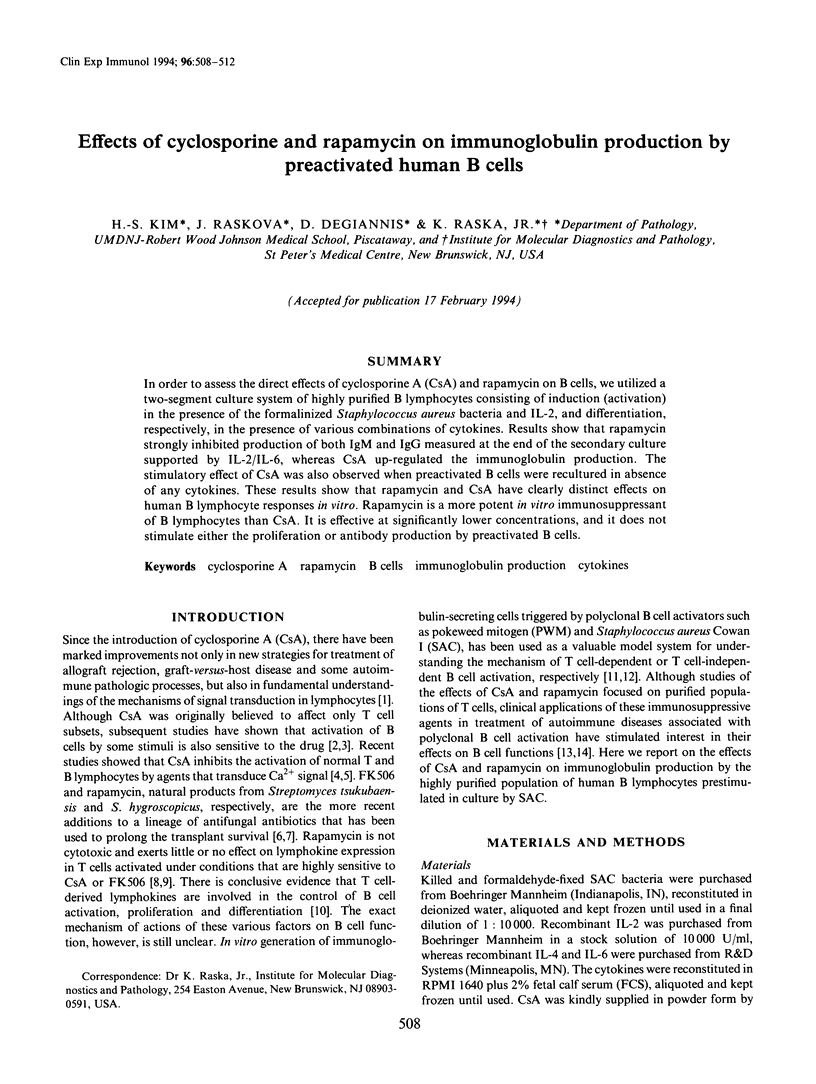Abstract
In order to assess the direct effects of cyclosporine A (CsA) and rapamycin on B cells, we utilized a two-segment culture system of highly purified B lymphocytes consisting of induction (activation) in the presence of the formalinized Staphylococcus aureus bacteria and IL-2, and differentiation, respectively, in the presence of various combinations of cytokines. Results show that rapamycin strongly inhibited production of both IgM and IgG measured at the end of the secondary culture supported by IL-2/IL-6, whereas CsA up-regulated the immunoglobulin production. The stimulatory effect of CsA was also observed when preactivated B cells were recultured in absence of any cytokines. These results show that rapamycin and CsA have clearly distinct effects on human B lymphocyte responses in vitro. Rapamycin is a more potent in vitro immunosuppressant of B lymphocytes than CsA. It is effective at significantly lower concentrations, and it does not stimulate either the proliferation or antibody production by preactivated B cells.
Full text
PDF




Selected References
These references are in PubMed. This may not be the complete list of references from this article.
- Bierer B. E., Mattila P. S., Standaert R. F., Herzenberg L. A., Burakoff S. J., Crabtree G., Schreiber S. L. Two distinct signal transmission pathways in T lymphocytes are inhibited by complexes formed between an immunophilin and either FK506 or rapamycin. Proc Natl Acad Sci U S A. 1990 Dec;87(23):9231–9235. doi: 10.1073/pnas.87.23.9231. [DOI] [PMC free article] [PubMed] [Google Scholar]
- Chen H., Wu J., Xu D., Luo H., Daloze P. M. Reversal of ongoing heart, kidney, and pancreas allograft rejection and suppression of accelerated heart allograft rejection in the rat by rapamycin. Transplantation. 1993 Sep;56(3):661–666. doi: 10.1097/00007890-199309000-00031. [DOI] [PubMed] [Google Scholar]
- Dumont F. J., Staruch M. J., Koprak S. L., Melino M. R., Sigal N. H. Distinct mechanisms of suppression of murine T cell activation by the related macrolides FK-506 and rapamycin. J Immunol. 1990 Jan 1;144(1):251–258. [PubMed] [Google Scholar]
- Fischer G., Wittmann-Liebold B., Lang K., Kiefhaber T., Schmid F. X. Cyclophilin and peptidyl-prolyl cis-trans isomerase are probably identical proteins. Nature. 1989 Feb 2;337(6206):476–478. doi: 10.1038/337476a0. [DOI] [PubMed] [Google Scholar]
- Hess A. D. Mechanisms of action of cyclosporine: considerations for the treatment of autoimmune diseases. Clin Immunol Immunopathol. 1993 Aug;68(2):220–228. doi: 10.1006/clin.1993.1122. [DOI] [PubMed] [Google Scholar]
- Hornung N., Raskova J., Raska K., Jr, Degiannis D. Responsiveness of preactivated B cells to IL-2 and IL-6. Effect of cyclosporine and rapamycin. Transplantation. 1993 Oct;56(4):985–990. doi: 10.1097/00007890-199310000-00039. [DOI] [PubMed] [Google Scholar]
- Howard M., Paul W. E. Regulation of B-cell growth and differentiation by soluble factors. Annu Rev Immunol. 1983;1:307–333. doi: 10.1146/annurev.iy.01.040183.001515. [DOI] [PubMed] [Google Scholar]
- Liu J., Farmer J. D., Jr, Lane W. S., Friedman J., Weissman I., Schreiber S. L. Calcineurin is a common target of cyclophilin-cyclosporin A and FKBP-FK506 complexes. Cell. 1991 Aug 23;66(4):807–815. doi: 10.1016/0092-8674(91)90124-h. [DOI] [PubMed] [Google Scholar]
- Luo H., Chen H., Daloze P., Chang J. Y., St-Louis G., Wu J. Inhibition of in vitro immunoglobulin production by rapamycin. Transplantation. 1992 May;53(5):1071–1076. doi: 10.1097/00007890-199205000-00019. [DOI] [PubMed] [Google Scholar]
- Peest D., Schaper B., Nashan B., Wonigeit K., Raude E., Pichlmayr R., Haverich A., Deicher H. High incidence of monoclonal immunoglobulins in patients after liver or heart transplantation. Transplantation. 1988 Sep;46(3):389–393. doi: 10.1097/00007890-198809000-00011. [DOI] [PubMed] [Google Scholar]
- Schreiber S. L. Chemistry and biology of the immunophilins and their immunosuppressive ligands. Science. 1991 Jan 18;251(4991):283–287. doi: 10.1126/science.1702904. [DOI] [PubMed] [Google Scholar]
- Shevach E. M. The effects of cyclosporin A on the immune system. Annu Rev Immunol. 1985;3:397–423. doi: 10.1146/annurev.iy.03.040185.002145. [DOI] [PubMed] [Google Scholar]
- Starzl T. E., Fung J., Jordan M., Shapiro R., Tzakis A., McCauley J., Johnston J., Iwaki Y., Jain A., Alessiani M. Kidney transplantation under FK 506. JAMA. 1990 Jul 4;264(1):63–67. [PMC free article] [PubMed] [Google Scholar]
- Suzuki N., Sakane T., Ueda Y., Murakawa Y., Tsunematsu T. Implications for the role of cognate interactions in in vitro human B cell activation by Staphylococcus aureus Cowan I and pokeweed mitogen. J Clin Invest. 1986 Jan;77(1):294–300. doi: 10.1172/JCI112290. [DOI] [PMC free article] [PubMed] [Google Scholar]
- Walz G., Zanker B., Melton L. B., Suthanthiran M., Strom T. B. Possible association of the immunosuppressive and B cell lymphoma-promoting properties of cyclosporine. Transplantation. 1990 Jan;49(1):191–194. doi: 10.1097/00007890-199001000-00042. [DOI] [PubMed] [Google Scholar]
- Wicker L. S., Boltz R. C., Jr, Matt V., Nichols E. A., Peterson L. B., Sigal N. H. Suppression of B cell activation by cyclosporin A, FK506 and rapamycin. Eur J Immunol. 1990 Oct;20(10):2277–2283. doi: 10.1002/eji.1830201017. [DOI] [PubMed] [Google Scholar]


